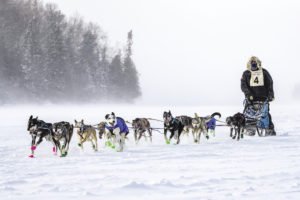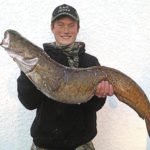Mush Lake Racing Dog Blog
A family-friend asked me recently what I think about for all those hours on the dog sled. A typical training run mid-winter can vary from two to six hours. It might be dark and it might be well below zero.
Sometimes, I told her, I think about life—about things completely outside of mushing and dogs and where I am at that moment. But the majority of the time, I am looking at the dogs or thinking about my own condition—whether my fingers are numb, my face raw, or my legs tired.
On the back of the dog sled, the view ahead consists of a trail, snow-covered trees and the back ends of a team of dogs. The musher has a clear view of each dog’s gait, the harness and the tug line that attaches the dog to the gangline. Especially in the day light, it is difficult to not focus on the tug lines. If a dog has a tight tug, usually all is well. But if a tug goes loose, I can spend an entire run staring at that dog, wondering if there is something wrong or if it’s just an off day.
It is easy to fixate on one dog that has a loose tug line…or to stare, wondering if the tug is really loose or taut. Is that Buda pacing? Is Emmy’s butt pulling out to the side? Why is Victory running on the wrong side of the gangline? Should I stop and fix it or should I ignore it for now?
And what about me? I am getting cold. Should I make myself eat something? Probably. But that would mean taking my gloves off to unwrap a snack bar, which I really don’t want to do. The further the musher lets themselves go down the spiral toward cold and hunger, the more difficult it is to pull it together.
These thoughts all sound trivial, benign. But it’s one of the things I love about mushing. I get out of my head of larger world problems and focus on the small things right in front of me. Sometimes, everything is clicking. Every tug is tight, I am warm, we are whooshing along on the trail, and I can focus on the winter landscape sliding by. The dogs and I are content to just be.
Around the time this issue goes to the hands of readers, Matt and 14 dogs will be trotting along the Beargrease trail. I have run the mid-distance Beargrease and the marathon two times each, and until now, would not relinquish my favorite race to my husband. But now it’s his turn and I am excited for him to experience this race. He has done his share of difficult dog sled races, but the Beargrease will be different, in part because of the length—373 miles this year and in part because of the hills.

As chief handler, I will drive the truck to each of the seven checkpoints, plus the start and finish with our crew of handlers, and we will be ready with straw, food for the dogs, and food for the musher. While the musher rests for a few hours at each stop, the handlers will go over each dog—massaging their muscles, watching for any soreness, feeding them, and bedding them down on straw with fleece blankets so they too can sleep.
In early January, we had a practice round for the Beargrease at the Gunflint Mail Run sled dog race up the Gunflint Trail. Seventeen teams took part in two different races—an eight dog 60-mile race, and a 12-dog 100-mile race. Temperatures the day of the race topped out at 0 degrees F, with wind chills hovering around -20 F. The dogs performed remarkably well in these temperatures, but it is more difficult for the musher, handling crews and volunteers.
With 1,200 miles of training on this team, a second place finish in the first race of the season, and a team of veterans, many of whom have finished the Beargrease in the past, we are feeling better than ever about the Beargrease this year.
Maintaining this positive attitude throughout the dog sled race is where the musher’s head needs to be. It’s easy to dwell on tug lines and dog gaits, especially if the run gets difficult. If Matt wants to have a “magic carpet ride” in the Beargrease that all mushers desire, he will need to keep it positive—singing to the dogs, taking care of himself and enjoying the ride. If he can do this, it will be magical for sure.




